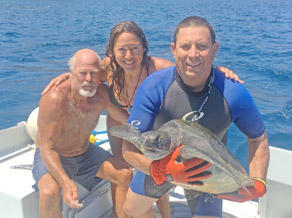For The Islander
For about a week leading up to Friday, Aug. 12, Marine Animal Rescue (MAR) field officers had been receiving multiple reports of a sea turtle near Lover’s Cove adjacent to Avalon which had been fouled with fishing hooks and trailing lines.
For The Islander
For about a week leading up to Friday, Aug. 12, Marine Animal Rescue (MAR) field officers had been receiving multiple reports of a sea turtle near Lover’s Cove adjacent to Avalon which had been fouled with fishing hooks and trailing lines.
With each response, (a half dozen) the outcome was frustratingly the same. The animal, while having just been seen by snorkelers, kayakers, glass bottom boat skippers, etc, within the past 30 minutes or so, could not be located by responding MAR field officers once on scene to determine its condition.
The elusive “Honu” (Hawaiian for turtle) was obviously mobile and not floating on the surface where it could be easily tracked. Since it was still swimming and diving, it made locating the one small animal in a very large volume of water a daunting challenge.
Depending on the amount of trailing line and severity of the hook entanglement, the animal’s health was legitimately in jeopardy since getting the line snagged on rocks or some other submerged object could render the turtle trapped underwater, which would eventually drown it.
On the morning of the 12th, Avalon residents Suri Phaungphakdi and Greg Harris (who are both members of a local swim club), were snorkeling near Abalone Point when they spotted the turtle hovering underwater. Greg remained in visual contact with the animal while Suri swam to shore to use her cellphone to report it to me. I grabbed a large capture net and called Avalon Harbor to assist since each minute was critical and deploying the MAR patrol boat may have taken up valuable and much needed response time.
Habor Patrolman Curt Cameron picked me up at Avalon Float 5 and we proceeded to Abalone Point where Suri and Greg were following the turtle from a safe distance.
Cameron, who was instrumental in the rescue effort, maneuvered the Avalon Harbor vessel near the creature each time it neared the surface for a breath, but the turtle was extremely wary of the boat and with each approach it darted into a dive long before I was able to even pretend to get the net near it.
After several failed attempts, ‘Plan B’ was launched. I slid in the water and among four separate individuals keeping tabs on it I waited for the turtle to resurface again for air. After about 20 minutes our quarry began a slow ascent toward the surface. I positioned myself directly behind it and once it got within a few feet of the surface I was able to reach out and hand capture it and make a rapid transfer to Curt Cameron waiting on the swim-step of the harbor boat. Quickly all three swimmers boarded the craft and moved the animal to the main deck, where I was able to perform a fairly routine in-field removal of the hook and line.
Afterwards, a full body inspection to search for any additional injuries or causes for concern revealed none and the Honu (which was later suspected to be an Olive-Ridley sea turtle) was released back into the water to carry on its life. A raucous celebration ensued on board the harbor rescue boat.
The turtle rescue became case number 564 for Marine Animal Rescue in just over 3-1/2 years of operation throughout Catalina waters. When I first took on the role of field operations lead in November of 2012 I had no idea that so much need existed for responding to injured or poorly located creatures surrounding the island and Avalon.
MAR is a 30-year-old not for profit, Los Angeles County-based organization headed up by Founder Peter Wallerstein and comprises teams of field officers working the beach zones throughout L.A. County.
When called upon, it will even reach beyond into adjacent counties north and south. MAR is fully sanctioned by Federal agencies NOAA and the Dept. of National Marine Fisheries, which authorize our field agents to legally respond to and handle all forms of marine mammals protected through the Marine Mammal Protection Act. This includes whales, dolphins, pinnipeds-(seals and sea lions) and additionally all shore birds, which fall into a separate category.
The Catalina Island division of Marine Animal Rescue was formed out of necessity to address the many reports emanating from the island but were unable to be responded to in a timely fashion from the mainland because of distance logistics, It includes dedicated personnel such as Darwin Horn, Eric Mahan, Dr. Richard and Anney Denney, and the entire staff of Avalon Animal Hospital along with many caring volunteers.
Documented data supports the theory that the overwhelming number of ocean-related animal injury reports around the island seem to involve some form of entanglement with fishing hooks and line, plastics or some type of netting. Unfortunately, we also see a disturbing amount of gunshot injuries, or improvised explosive device injuries to marine mammals as well.
That fact is particularly troubling since I cannot comprehend why it is that some people can’t recognize that we share this planet with other living things that also have a right to exist. Shore-based responses involve many birds with similar hook and line entanglements along with broken wings or some other form of body trauma and of course during pup weaning season (December thru May) we respond to an incredible amount of wayward seal and sea lion pups simply trying to figure out where to go without mom.
In the majority of cases, quick reaction through a well established reporting network is key. The network includes Avalon Sheriff’s dispatch, Avalon Harbor Dept., City and County fire departments, Avalon Chamber of Commerce, The Catalina Conservancy, City of Avalon, Catalina Express, Express Helicopter service, the freight yard, building supply, and Southern California Edison.
Its size and scope has enabled MAR to reach compromised animals in a very short timeframe and more than 90-plus percent of these animals are successfully treated and released.
Of course Catalina Island is an incredibly unique location, so it stands to reason that MAR’s realm of responsibility surrounding the island would sort of follow suit. By description, “Marine Animal Rescue” conjures images of seals, dolphins, whales and the like, but due to our growing reputation as a reliable “go-to” animal rescue resource which has blossomed in the past few years, MAR has evolved. It has also been called into action for dozens of injured deer, Island Fox, or animals in locations which put either it, or the public, at risk. Creatures such as rattlesnakes, Gopher snakes, and birds ranging from Eagles and Osprey to Herons and Hummingbirds are all on the usual suspect’s list for MAR now.
Much of MAR’s daily interactive work is centered around public outreach educational efforts as we routinely explain normal versus abnormal animal behaviors.
This is especially true when it comes to seals and sea lions hauling out on beaches, which many people will interpret as a sign of distress. People often equate this beaching behavior as looking like whale or dolphin strandings. Seals and sea lions exit the water almost daily to rest and warm themselves. When they do so on public access areas it can become problematic, but only in the sense that now people can also access them and regularly attempt to.
Our team effort between MAR and Avalon Harbor along with some good samaritan citizens resulted in just the latest successful rescue effort for one little Honu in Catalina waters.
It certainly won’t be the last animal in need of help, but because it was unusual, unique and involved multi-agency personnel, equipment and public assistance it was also one to cherish, celebrate and remember.
For more information regarding Marine Animal Rescue, please visit our website; http://www.marspecialists.org.











